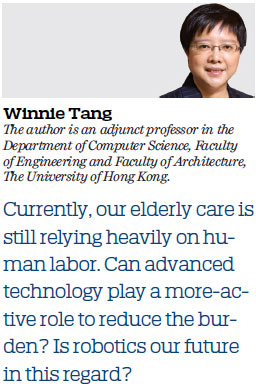‘Silver economy’ provides many golden business opportunities
Updated: 2019-10-29 07:41
By Winnie Tang(HK Edition)
A new study in the United States found that over one-quarter of the caregivers for the elderly in the country are new immigrants, and the US Labor Department expected that the caregiver industry will grow by over 40 percent in the next 10 years, far ahead of other industries. This echoes the prediction by Hong Kong Labour and Welfare Secretary Law Chi-kwong that the city will need at least another 240,000 foreign domestic helpers, an increase of over 66 percent of the current figure, within the next few decades due to the aging population. In Japan, a large number of foreign workers to fill the 380,000 caregiver vacancies by 2025 is desperately needed.
The work of caring is often round-the-clock, and foreign helpers play an important role. According to a survey, Hong Kong’s foreign domestic helpers, mostly without proper training in elderly care, generally have to work overtime, and they often suffer injury, overwork and even emotional problems. The survey was conducted by the Mission For Migrant Workers, a local organization, on 1,500 domestic helpers from the Philippines, Indonesia, Thailand, and other places.
Currently, our elderly care is still relying heavily on human labor. Can advanced technology play a more active role to reduce the burden? Is robotics our future in this regard?
Among the countries with an aging population, Japan has the most positive attitude about using robotics for elderly care, seeing them as a helpful and friendly helping hand.

In fact, to many elderly who live alone, a robot or a therapy animal can be a conversation partner for them. Therefore, it is no surprise that a furry seal that can cry softly like a baby, for example, has attracted a great demand from clients, including 400 senior homes in Denmark.
However, the cute seal is expensive, costing 5,000 euros ($5,550) each in Europe. The reason for its high price is that product development has taken more than 10 years, and the support of $20 million from the government.
The high cost is surely a major issue for one to enjoy retirement. Apart from material needs, smart facilities and equipment are also essential to empower individuals to be “aging in place”, i.e., to allow the elderly to live independently and comfortably in an environment they are familiar with. That’s why many see the “smart home” model as necessary for the future senior home.
In a smart home, all kinds of electrical appliances and each piece of furniture are interconnected via the internet. For example, the bed, the floor, the TV, the refrigerator, the toilet bowl, the couch, etc., in the smart home are all installed with sensors. The real-time data collected from various devices will be used for analyzing the well-being of the habitant. The testing of 3D laser sensor by IBM and a startup recently to see if it helps the elderly live alone is one example. This technology, using laser light pulses to render high-resolution images of the surrounding, was originally used for navigation in autonomous vehicles.
The trial run is to see if the technology can build up a detailed picture of the daily routine of the elder. In case of changes in gait or a slip, the caregiver will be notified immediately without the need to stay nearby all the time. The idea sounds great, but such a device costs $1,000.
Aside from the high price being an obstacle to the broad adoption of the smart home, US business-news website Business Insider pointed out that the smart home has not yet entered the mass market because electrical appliances and smart furniture have their own networks and standards. In short, they are not compatible with each other. The interoperability problems have confused consumers, not to mention the difficulty with integrating all the collected data for analysis. Moreover, people tend to replace the electrical appliance only when it stops working. As a result, it takes a long time to get the full set of smart furniture to be synchronized in a home.
Therefore, it is good for the Hong Kong government to provide a $1 billion fund for innovative elderly care products. But apart from that, can the government coordinate and encourage the industry to agree on selecting a common standard, just as the European GSM (Global System for Mobile Communications) was selected over the US’ CDMA (Code Division Multiple Access) for mobile phone networks? In this case, the startups can develop products in the early stage without the worry of not matching later standards. By doing so, it is expected to lower the price, and turn the silver-haired global trend into a golden business opportunity.
(HK Edition 10/29/2019 page8)
